Greater Amberjack
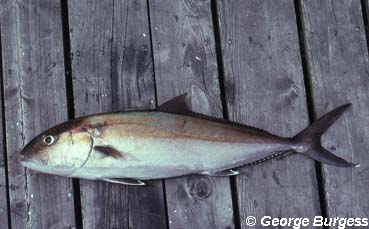
Seriola dumerili
This large fish is slender and agile, and can grow to be more than 6 feet long. Its is mostly a silvery white color, with a darker gray or bluish coloring from above. This is a popular recreational fish but because it is in the of the apex of the marine food chain, the larger ones carry considerable risk of ciguatera poisoning.
Order: Perciformes
Family: Carangidae
Genus: Seriola
Species: dumerili
Common Names
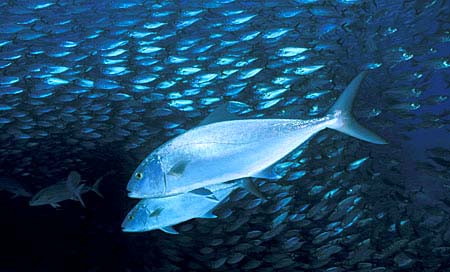
Common English language names of this species include greater amberjack, allied kingfish, amberjack, great amberfish, great yellowtail, greater yellowtail, jenny lind, purplish amberjack, rock salmon, sailor’s choice, and yellow tail. Other common names are acciola (Italian), accola (Italian), aji-aji (Malay), alice grande (Italian), alici (Italian), alicosa (Italian), amber couvailli (French), anchova (Portuguese), arabaiana (Portuguese), arabaiana pintada (Portuguese), aricciola (Italian), ztún medregal (Spanish), avci baligi (Turkish), barema (Arabic), blanquilla (Spanish), bärnstensfisk (Swedish), cá Cam (Vietnamese), cavagnola (Italian), cervjola (Maltese), chaet-pang-o (Korean), charuteiro (Portuguese), charuteiro-catarino (Portuguese), chermin (Malay), cola amarilla (Spanish), coronado (Spanish), coronado de ley (Spanish), doronado (Spanish), enchova (Portuguese), esmoregal (Portuguese), gao ti shi (Mandarin Chinese), gazala (Arabic), gof (Slovene), gofa (Albanian), groot geelstert (Afrikaans), halwayo (Arabic), hamam (Arabic), inch (Arabic), intias (Hebrew), isopiikkimakrilli (Finnish), jarrupe (Italian), jibb (Arabic), kabiou (Papiamento), kahala (Hawaiian), kanpachi (Japanese), lampuga (Italian), lecc (Italian), leccia (Italian), lecciutte (Italian), licciòla (Italian), lírio (Portuguese), lissa (Italian), lissa bastarda (Italian), lupina (Italian), machiamarillo (Spanish), madregal (Spanish), madregal coronado (Spanish), magiatiko (Greek), manali (Greek), marang (Cebuano), mayatiko (Greek), medregal (Spanish), medregal coronado (Spanish), mineri (Greek), occhio grasso (Italian), olhete (Portuguese), olho-de-bois (Portuguese), paanget (Kumak), peixe-limão (Portuguese), pez de limón (Spanish), pez limon (Spanish), pitangola (Portuguese), poisson limon (French), ricciola (Italian), sarikiyruk baligi (Turkish), sartaleone (Italian), seriol atlanti (Hebrew), seriola (Hebrew, Italian, Norwegian, Spanish, Swedish), seriola di dumeril (Italian), seriola olbrzymia (Polish), sériole couronnée (French), serjola (Maltese), serra (Maltese), serviola (Spanish), shi (Mandarin Chinese), sholah (Arabic), sirviola (Italian), stor ravfisk (Danish), sumu (Italian), talakitok (Tagalog), tapireçá (Portuguese), teutevu niu (Gela), tonto (Tagalog), tsola (Arabic), urubaiana (Portuguese), and xaréu coronado (Portuguese).
Importance to Humans
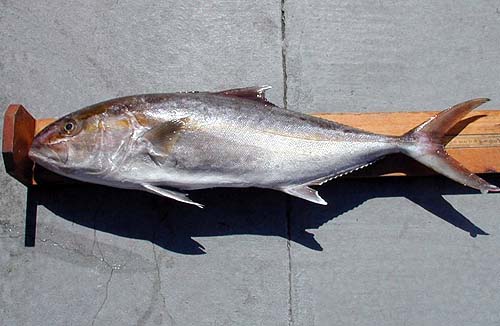
The greater amberjack is considered a popular game fish as well as a commercially caught species. Caught primarily with hydraulic reels, hand-lines, roads-and-reels, and traps, the flesh is marketed fresh in Florida and Mexico. The flesh can be fried, broiled, baked, or grilled for human consumption and is considered moderately good in taste. Due to the popularity of this fish, it has recently received some attention in the aquaculture industry.
Danger to Humans
Large greater amberjacks have been implicated in cases of ciguatera poisoning within certain areas of its range. Ciguatera poisoning is caused by the bioaccumulation of ciguatoxins in the flesh of tropical marine fishes. Ciguatoxins are produced by marine dinoflagellates that grow attached to marine algae and as such may be incidentally ingested by herbivorous fishes. Large piscivorous reef dwelling fishes occupying the apex of the food chain become reservoirs for the highest amounts of ciguatoxin by feeding on other members of the reef community. Poisoned people report gastrointestinal maladies that may last several days, a general weakness in their arms and legs, and a reversal in the ability to differentiate hot versus cold. The illness is serious and symptoms may persist for weeks.
Conservation
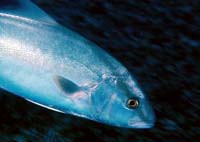
Strict regulations have been in place since 1998 within the Gulf of Mexico fishery. Recreational fishers are limited to a 1-fish bag limit and a 28″ minimum length while commercial fishes are restricted to a minimum size of 36″ in length and a seasonal closure of the fishery from March through May. On the Atlantic coast of Florida, regulations are similar to the Gulf with the exception of a closed season in April and a commercial catch quota in federal waters. At this time, the World Conservation Union (IUCN) does not consider the greater amberjack to be vulnerable or threatened. The IUCN is a global union of states, governmental agencies, and non-governmental organizations in a partnership that assesses the conservation status of species.
> Check the status of the greater amberjack at the IUCN website.
Geographical Distribution
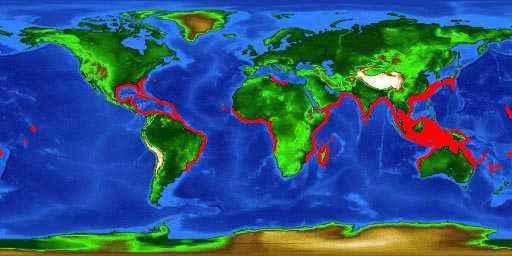
The greater amberjack is found in subtropical regions throughout the globe. In the Indo-West Pacific, this species has been reported from South Africa, the Persian Gulf, southern Japan and the Hawaiian Islands, south to New Caledonia, and the Mariana and Caroline Islands in Micronesia. In the western Atlantic Ocean, the greater amberjack is found off Nova Scotia, Canada south to Brazil including Bermuda, the Gulf of Mexico, and the Caribbean Sea. Although the greater amberjack is often confused with the closely related S. carpenteri, it has been documented in the eastern Atlantic Ocean from the British coast south to Morocco and into the Mediterranean.
Habitat
A subtropical species, the greater amberjack is often associated with rocky reefs, floating debris, and wrecks at depths ranging from 60-240 feet. It has also been reported at inshore locations off the coast of Florida. Studies have shown that some greater amberjack populations are full time residents along the gulf and Atlantic coasts of Florida while other populations migrate from the South Atlantic Bight into inshore waters during certain times of the year.
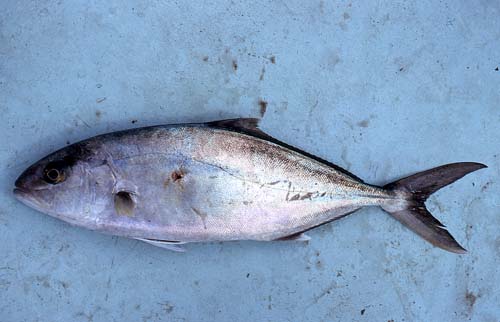
Greater amberjack congregate in schools when they are young, however this schooling behavior decreases as the fish grows older. The oldest fish are primarily solitary.
Biology
Distinctive Features
The greater amberjack is slender, fusiform jack with a short and pointed head and relatively small eyes. The terminally located mouth is large with a posteriorly broad maxilla reaching the middle of the eye. The pectoral fins are shorter than the head, and approximately equal in length to the pelvic fins. The second dorsal fin is much longer than the anal fin and the caudal peduncle is deep with grooves above and below the base of the caudal fin. Finlets and scutes are absent in this species. The v-shaped caudal fin is lunate, or moon-shaped, efficient for fast swimming in pursuit of prey.
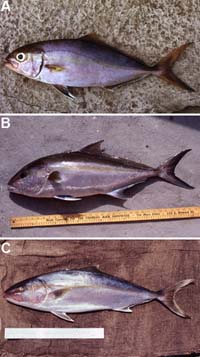
Often confused with other species, the greater amberjack may be distinguished by the number of gill rakers and the length of the anal fin. Gill rakers are finger-like extensions projecting from the front gill arch. Greater amberjacks possess 11-19 gill rakers and a long anal fin base. In contrast, lesser amberjacks (Seriola fasciata) have 21-24 gill rakers and a long anal fin base, almaco jacks (Seriola rivoliana) have 21-26 gill rakers and a long anal fin base, and banded rudderfish (Seriola zonata) have 12-16 gill rakers and a short anal fin base.
Coloration
The greater amberjack, largest of the jacks, has a brownish or bluish grey dorsal side (above the lateral line) and a silvery white ventral side. There is a dark amber stripe running from the nose to just in front of the dorsal fin. This stripe becomes more defined during feeding activity or when the fish is excited. The greater amberjack also has a dusky “mask” stretching from the upper jaw through the eye to the first dorsal fin. Some individuals may have a pale yellow stripe along the sides.
Juvenile greater amberjacks have five dark body bands that are vertically irregularly split with a sixth band at the end of the caudal peduncle. The body bands do not extend onto the dorsal and anal fin membranes; the fins are transparent.
Dentition
Greater amberjack have minute teeth arranged in a broad band in the upper and lower jaws.
Size, Age, and Growth
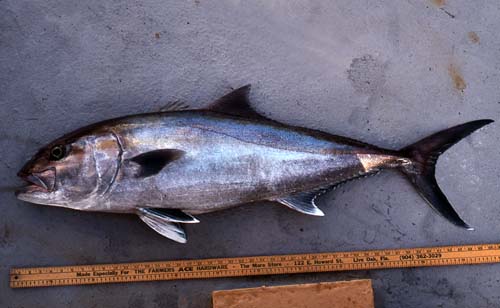
Great amberjacks grow to a maximum total length of 6.2 feet (1.9 m). Although the maximum published weight of this species is 80.6 kg, these fish typically reach about 39.7 pounds (18 kg) in weight. Females grow larger in size and live longer than males. Maximum life span is believed to be at least 17 years. Sexual maturity is attained at approximately 4 to 5 years of age.
Food Habits
As opportunistic predators, greater amberjacks feed on benthic and pelagic fishes as well as squid and crustaceans. Fish commonly preyed upon by the greater amberjack include the bigeye scad (Selar crumenophthalmus) and sardines (Sardinella aurita, and Sardinella pilchardus). Juvenile greater amberjacks feed on plankton such as decapod larvae and other small invertebrates.
Reproduction
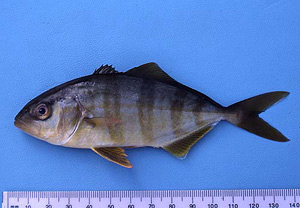
Although there is little known about the reproductive habits of the greater amberjack, it is believed that migrations are related to reproduction. In the western Atlantic Ocean, this species spawns offshore from March through June. Spawning locations include reefs and shipwrecks as evidenced by the numbers of young individuals in these locations during the summer months.
Predators
Predators of the greater amberjack include larger fishes and seabirds including the yellowfin tuna (Thunnus albacares), European wake (Merluccius merluccius), brown noddy (Anous stolidus), and sooty tern (Sterna fuscata).
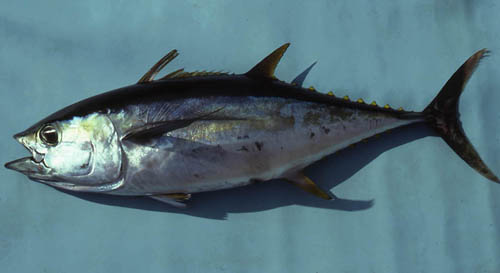
Parasites
Tapeworms occasionally infest greater amberjacks. Although this may be unappetizing, the worms are harmless to humans and may be cut away from the flesh and discarded prior to cooking. A monogean parasite (Zeuxapta seriolae) has been documented as parasitizing the gills of the greater amberjack.
Taxonomy
The greater amberjack was originally described as Caranx dumerili by Risso in 1810. This name was later changed to the currently valid Seriola dumerili (Risso 1810). Synonyms used in past scientific literature referring to this fish includeTrachurus aliciolus Rafinesque 1810, Trachurus fasciatus Rafinesque 1810, Seriola boscii Valenciennes 1833, Seriola purpurescens Temminck & Schlegel 1845, Seriola gigas Poey 1860, Seriola simplex Ramsay & Ogilby 1886, Regificola parilis Whitley 1948, and Seriola rhombica Smith 1959.
Prepared by: Cathleen Bester